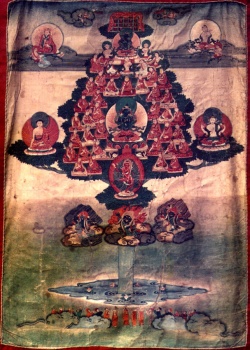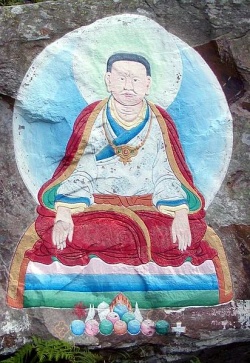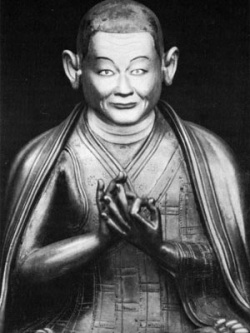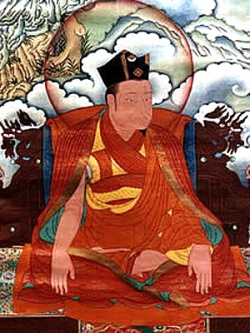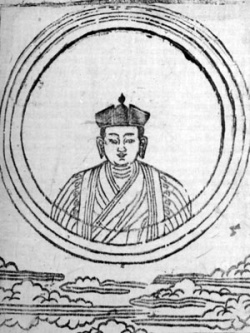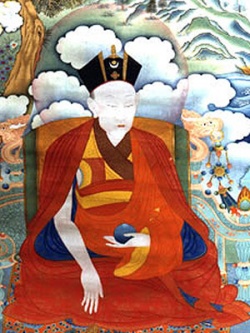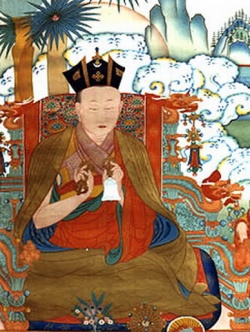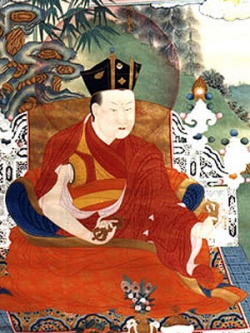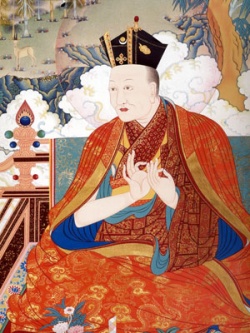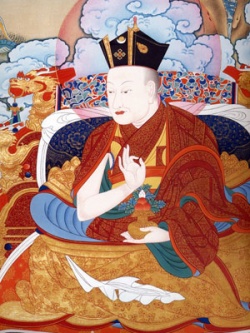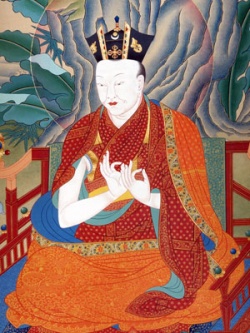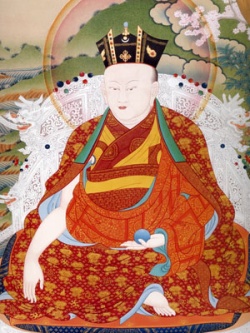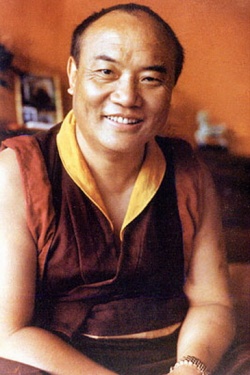The Golden Rosary
Introduction
Tibetan Buddhism is structured on the notion of 'transmission', the passing on of teachings and methods from the teacher to the student - who in his turn hands on the teachings to his own students.
This has given rise to a number of 'lineages'; lines of descent of Dharma wisdom from one great master to the next.
These masters are often 'reincarnate lamas' [tib.: Tulku), with alternate 'lineage-holders' holding the transmission during the period from the death of the reincarnate to the coming of age of his next incarnation.
The Karma Kagyu school of Tibetan Buddhism is an example of one such lineage.
The Karmapa, who first incarnated in the 12th century and is now in his 17th incarnation, is [as an institution] a treasury of teachings; his lineage holders - reincarnates themselves - are the Shamar, Tai Situ, Jamgon Kontrul and Gyaltsap Rinpoches.
This is sometimes called the Whispering Lineage, not because the master literally whispered the teaching to his pupil, but rather in reference to the continual verbal transmission to a select number of high caliber students of teachings that were never written down on paper].
The Karma Kagyu Lineage is the Yogic transmission among the four main schools of Tibetan Buddhism.
It encompasses both the old (Nyingma) and the new (Sarma) teachings which reached Tibet. Being heavily practice oriented, the Kagyu is called the ' oral school' or the ' perfection school.
The origin of the Kagyu Lineage dates back to the ninth century at the time of the full flowering of Tantric Buddhism in India.
The first teacher in this tradition was Tilopa, the renowned yogi and Mahasiddha (perfected one).
Tilopa received the transmission directly from Dorje Chang (skt.: Vajradhara), the celestial Buddha who symbolises the Dharmakaya, the ultimate mind.
Tilopa in turn gave the whispered teachings to Naropa who had previously been chancellor of Nalanda University in India.
Naropa's twelve years of service to Tilopa are regarded as a great example of devotion to one's teacher.
The first Tibetan to receive the teaching was Marpa, the Translator, so named because of his heroic efforts to reach India on foot, searching for his teacher Naropa, and patiently practising and translating the Mahamudra teachings into Tibetan.
Marpa was a householder and landowner and he gathered around him a number of students; the main one was Milarepa.
Because of the bad karma acquired through his early deeds as a sorcerer, Milarepa was submitted to years of arduous purifying labor before Marpa would grant him the teachings.
Milarepa spent many years meditating in caves, gained profound illumination and was famed as a poet and saint.
He died at the age of 80, at which time the lineage passed onto Gambopa who had previously been a doctor.
Gambopa was the first monk of the Kagyu School and he organised the Kagyu monastic system.
He also formulated the teaching in practical texts such as the 'Jewel Ornament of Liberation' which outlines the gradual path to liberation.
Four major and eight minor schools originated from Gampopa's four main disciples [the first Karmapa Dusum Khyenpa, Phagmodru Dorje Gyaltsen, (Tsalpa Weungom Tsultrim Nyingpo and (Bahrum Dharma Wangchuk).
The major schools have all fused into the Karma Kagyu with the Karmapa as the head.
The first Karmapa, Dusum Khyenpa, was Gampopa's most gifted disciple.
He manifested great spiritual power and purity early in his life and in his sixteenth year he received a supernatural Black Crown from dakinis and other divinities which bestowed knowledge of the past, present and future.
This hat has been passed on to all the subsequent Karmapas who are reincarnations or Tulkus of Dusum Khyenpa.
All the Karmapas have worked unceasingly to spread the Buddha's teaching, and are recognised as emanations of the bodhisattva Chenrezig (skt.:Avalokitesvara).
Tilopa
The Karma Kagyu lineage traces itself back over two hundred years before the first Karmapa, to the Indian source of their knowledge - Tilopa.
He is often to be seen at the top of the traditional paintings or thangkas of Kagyu refuge trees and looking every inch the ascetic.
A Brahmin, from East India, Tilopa was only a boy when he encountered the famous master Nagarjuna,
whose supernatural abilities later caused a state oracle to select Tilopa as ruler of a small Indian kingdom.
Some years later, disenchanted with worldly power, he became a monk at the Tantric Temple of Somapuri in Bengal.
We are told that one day a Dakini (a female wisdom-giver) came to him in a vision, and offered him her knowledge as a route to enlightenment.
Seizing his opportunity, Tilopa requested her teachings, and received the initiation into the Chakrasamvara Tantra - which, such were his abilities, he was easily able to understand.
For twelve years he practised this teaching at Somapuri, but when the monastery saw him take a female consort for the practice of union yoga, he was forced to quit the community.
Tilopa profited from his expulsion by travelling throughout India, searching out many teachers, and learning their methods.
He earnt his living during this period by grinding sesame seeds ('Til ' in Sanskrit) for oil - giving him the name by which we know him today.
He was given direct transmission of the Mahamudra and other teachings, by the Buddha Vajradhara (tib.: Dorje Chang), who became his root guru.
Although he chose to live in remote and inhospitable regions, his fame as a meditation master brought him excellent students, from whom he selected Naropa as the lineage holder.
Naropa
Born Samantabhadra, a Bengali prince, Naropa (1016-1100) rebelled young against his royal training.
Eight years old, he demanded to go to Kashmir, to follow an intellectual education with the best teachers of the age; three years later, he finally embarked upon the study of logic, science, grammar, rhetoric and art.
Meanwhile his parents, according to the custom of the time, had arranged for his marriage to Vimaladipi, a Brahmin.
The ceremony took place upon his return, but eight years later Naropa insisted on its dissolution, and promptly returned to Kashmir to be ordained [as a monk) and to undertake further study.
Several years later, at twenty-eight, his interests drew him to Nalanda University, near Pullahari, famous for its Buddhist philosophers, and of which he became Abbot in due course.
But then a Dakini appeared to him, telling him that meditation practice was more important than philosophizing, and that he should search out a certain Tilopa for instructions.
Abandoning his vows, Naropa set out to the East to find this teacher - often seen paired with Naropa in thangkas.
He did eventually meet Tilopa, without recognising him, and was put to twelve gruelling tests. He persevered, however, mastered Tilopa's teachings, and took disciples of his own.
Marpa
Two of these disciples were encountered on the road by a Tibetan, Marpa (1012-1097), who had come to Nepal in search of the Dharma.
Buddhist from his earliest youth, he had learnt Sanskrit from the Sakyapa Lama Drogmi, then exchanged all his belongings for gold, in preparation for his quest. So impressed was he by Naropa's disciples, he decided to become one himself.
For many years he received Naropa's teachings, as well as studying with a variety of famous Indian masters including Jnanagarbha, Kukuripa and Maitripa.
Having practised and mastered the teachings, Marpa returned to Lhodrag in South Tibet, where he lived with his wife Dagmema and their two sons, and spent several years translating the Buddhist scriptures from Sanskrit into the vernacular Tibetan.
Renowned as a translator, he attracted a group of students to whom he passed on the fruits of his Indian research.
After two further expeditions to India, from which he carried yet more teachings back over the mountain passes to Tibet, he returned to find a student named Milarepa had been sent to him.
Milarepa
From the Gungthang province of Western Tibet, close to Nepal, Milarepa (1052-1135) had had a hard childhood and a dark youth. Only seven when his father died, relatives had taken over his father's property, and maltreated the bereaved family.
His mother, bitter, sent Milarepa to train in black magic, to wreak revenge on those who had blighted her life.
Her wish was fulfilled - Milarepa proved adept at the practices he was taught, and unleashed a tide of destruction, killing many.
But he came to regret his actions, and looked for help in shedding the bad karma he had acquired during his vengeful adolescence.
He first attached himself to a Nyingmapa Lama Rongton, who, observing that Milarepa had an affinity for Marpa, sent him to await Marpa's return from his travels.
Milarepa's reward was to suffer years of testing at his master's hands. Among other trials, he built a nine-story tower, to Marpa's specifications.
But finally, Marpa gave Milarepa full transmission of all he had learnt from Naropa and other Indian masters.
Practising these teachings for many years, Milarepa attained enlightenment, and gained fame for his songs. Of his own students, Gampopa became his lineage-holder.
Gampopa
From Nyal, in East Tibet, Gampopa (1079-1135) was the son of a doctor, and a doctor himself. He married in his early twenties, and fathered two sons. Several years later, an epidemic took both their lives, despite his skill.
His wife falling sick of the same disease, and similarly failing to respond to his ministrations, begged him as she died not to marry again, but to become a monk.
One might question her motives, but nevertheless, at the age of twenty-six, Gampopa became a novice in the Kadampa tradition.
He applied himself, working with many masters, and achieved a high degree of proficiency before - at thirty-two - hearing talk of Milarepa.
Feeling a surge of devotion in response to these tales, and understanding that this must be his true teacher, he set out on a gruelling but eventually successful search to find him.
Gampopa, a talented writer, of great insight, was entrusted by Milarepa with the complete Kagyu transmission - the only one of Milarepa's students so honoured - before leaving Milarepa to go into retreat at Dhagpo in South- East Tibet.
There he founded the monastery of Dhaglha Gampo, where he drew many disciples.
Four of these were to found the four "major" Kagyu branches. Eight "minor" branches would appear later. One of the four, Dusum Khyenpa was both the next Kagyu lineage-holder, and the first Karmapa.
1st Karmapa Dusum Khyenpa
Born the son of a practising Buddhist in Ratay in East Tibet, Dusum Khyenpa (1110-1193) received his first dharma teachings from his father, and continued his education with other Buddhist teachers of the region until his twentieth year.
Then he moved to Central Tibet where he spent the next twelve years in meditation and in study with famous scholars, among them Kyabpa Chokyi Senge, and Patsab Lotsawa Nyima Trag.
At the age of thirty he was given Kagyu teachings by Gampopa; he was farther connected with the lineage by teachings he received from Rechungpa and from other students of Milarepa.
The depth of his practice was such that he developed siddhis [special powers and abilities] that enabled him to visit the sacred sites of the Vajrayana in India.
At one of these, Uddiyana, Dakinis shared their wisdom teachings with him. At forty-four, he left Central Tibet to return to the region of his birth, and spent the thirty-nine years until his death in establishing three thriving monasteries, sharing the Kagyu teachings, and training his students.
Of these, he chose Drogon Rechen to be the next lineage-holder.
Drogon Rechen
From Tsang, in Central Tibet, Drogon Rechen (1148-1218) was apprenticed to the Kagyu Lama Sangri Repa when only nine years old.
Before the lad was fully trained, the lama sickened, and knowing he would die, sent Drogon Rechen to find the disciples of Milarepa, knowing that they were capable of making his pupil an accomplished master.
In addition to following his master's advice, Drogon Rechen also took Nyingma teachings that originated with Vimalamitra, an Indian teacher. W
ith assiduous practice, he attained great realisation. Hearing reports of the first Karmapa, Drogon Rechen wanted to assess this potential rival.
At their meeting, the display of Karmapa's powers completely overwhelmed the younger man, who immediately became Karmapa's student.
He eventually received the full Kagyu transmission, and became the lineage-holder.
Pomdragpa Sonam Dorje
One day he was visited by one Pomdragpa Sonam Dorje (1170-1249), who he immediately recognised as highly talented, and the next Kagyu lineage holder.
This boy, literate since the age of five, and a student of Lama Lhakang Gang since the age of nine, had heard of Drogon Rechen when fourteen years old, and had felt compelled to see him,
certain that Drogon Rechen was to be his teacher.
Pomdragpa Sonam Dorje received the full Kagyu teachings, and became a gifted master, whose main student was the Karma Pakshi. the second Karmapa.
2nd Karmapa Karma Pakshi
From Chilay Tsakto in Eastern Tibet, the second Karmapa, Karma Pakshi (1204-1283), was something of a child prodigy. By the age of six, he had taught himself to read and write.
At ten, he was displaying a photographic memory for texts. On his way to Central Tibet for further education, he encountered Pomdragpa Sonam Dorje, who had been told by a vision of Dusum Khyenpa, the first Karmapa, that this boy would become the next lineage-holder.
Karma Pakshi was persuaded to stay, and received the Kagyu transmission.
In time, he became renowned for his powers, and had students throughout Tibet, China and Mongolia.
Drubtop Urgyenpa
Drubtop Urgyenpa (1230-1312) was the next to hold the lineage transmission.
From Lato, in Northern Tibet, he was a natural meditator, who decided that he should first study Buddhist philosophy before beginning serious meditation practice.
So, from his seventh to his sixteenth years, he applied himself to texts.
Then he went to Podong Er, a monastery in Tsang province famous for the quality of its teaching, where he excelled among his contemporaries.
Not one to rest on his laurels, he took the Kagyu teachings from the master Gotsangpa, before embarking on a period of travel to Nepal, China, Pakistan, and India, to learn from and meditate with as many teachers as he could find.
At fifty-three, he encountered Karma Pakshi, who in addition to giving Urgyenpa the full Kagyu teachings, predicted that he would become the main teacher of the third Karmapa, his next incarnation.
3rd Karmapa Rangjung Dorje
The Third Karmapa, Rangjung Dorje (1284-1339) was born in Dingri Langkor, startling those present by sitting up and proclaiming himself to be the Karmapa.
Three years later he renewed his assertions by making himself a black hat and again declaring himself to be the Karmapa.
Two more years were to pass before he met Drubtop Urgyenpa who recognised the child as the reincarnation of Karma Pakshi, and gave him the actual Black Crown, all the possessions of the second Karmapa, and - not least - all the Kagyu teachings.
Not content with this, Rangjung Dorje sought out masters of all the Buddhist traditions of the time, studying with Trophu Kunden Sherab and Nyenre Gendun Bum among others.
As a result, he achieved great fame, and attracted any disciples.
A practical man, he built bridges as well as meditation centres, benefiting his countrymen's daily life as well as their spiritual one.
For posterity, he wrote many texts and commentaries, preserving many of the teachings in a form we use today.
His two main disciples were Gyalwa Yungton Dorje Pal, who was to become the next lineage holder, and the first Shamarpa, Khaydrup Dragpa Senge.
The Shamarpa lineage is the second line of reincarnates in history of the Tibetan tradition (the Karmapas being the first), and began when Rangjung Dorje presented Khaydrup Dragpa Senge with a ruby-red crown, and the title Shamarpa (Holder of the Red Crown).
The Red Crown is an exact replica of the Black Crown worn by the Karmapas, and exemplifies the close relationship between them. These crowns are symbols of activities that benefit beings, and in no way denote separate lineages.
Both the "Black Hat Lama" and the "Red Hat Lama" are of the Karma Kagyu Lineage.
The Shamarpa is also known as a manifestation of Amithaba, the Buddha of Limitless Light.
Gyalwa Yungton Dorje Pal
Gyalwa Yungton Dorje Pal (1296-1376), was born in Southern Tibet, at Tsongdu Gurmo, in whose market square at the age of five, he met the scholar Trophu Khenchen Sonam Senge.
Breaking from his mother, the child showed such devotion that he was given refuge vows and the lay precepts there and then.
At fifteen he entered the Nyingma monastery Ugpa Lung where the Lamas Zurchung and Bale taught him the Tantrayana.
He continued his academic career at the monastic college of Shalu, achieving high renown as one who was adept in both the Sutras and Tantras.
Only after meeting the third Karmapa, and learning the ultimate meaning of the teachings, did he attain highest realisation.
4th Karmapa Rolpe Dorje
The fourth Karmapa, Rolpe Dorje (1340-1383) emulated his previous incarnation by sitting up at his birth, in Kongpo province in Central Tibet, and speaking - this time choosing to recite the mantra of Chenrezig, "Om Mani Peme Hung Hri".
Having - as that previous incarnation - left clear instructions with his secretary, Rinchen Pal, as to which signs to look for, the child was quickly found, and his training begun.
At six he took refuge vows and the lay precepts from Tokden Gon Gyalwa, who also taught the young Karmapa the Tantrayana.
He was twelve before, travelling to Central Tibet, he met the lineage holder Gyalwa Yungton Dorje Pal, and proceeded to convince the older man of his authenticity by recounting many anecdotes from his previous life as the third Karmapa.
He went on to request Gyalwa Yungton Dorje Pal to give him the transmission of the Kagyu teachings.
Once his education at the hands of his former student was complete, Rolpe Dorje travelled widely through Tibet and China, teaching and taking disciples;
the foremost of these was the second Shamarpa, who became the next lineage holder.
2nd Shamarpa Kacho Wangpo
The second Shamarpa, Kacho Wangpo, had been recognised by the fourth Karmapa as the reincarnation of Khaydrup Dragpa Senge, the first Shamarpa,
thus fulfilling a prediction of the second Karmapa, Karma Pakshi, that "future Karmapas will manifest in two forms".
Tibetan historical records, such as the texts of Golo Shonnu Pal (1392-1481), Pawo Tsuglag Trengwa (1504-1516), the fifth Dalai Lama, Ngawang Lozang Gyamtso (1617-1682)
and the eighth Situpa, Chokyi Jungnay (1700-1774), speak of the Karmapa as Karma Shanakpa (Karmapa the Black Crown Holder),
and of the Shamarpa as Karma Shamarpa (Karmapa the Red Crown Holder).
5th Karmapa Deshin Shegpa
Deshin Shegpa, the fifth Karmapa, (1384-1415), was born in the Nyang Dam region of Soutern Tibet, immediately sitting up, wiping his face, and declaring "I am the Karmapa - Om Mani Peme Hung Hri".
Rinchen Pal, the secretary to the third Karmapa, who identified and became secretary to the fourth Karmapa, also located this child, and in due course served him as secretary for the third time.
Deshin Shegpa was brought to Tsawa Phu in Kongpo where a significant number of the fourth Karmapa's disciples were living.
Shamar Kacho Wangpo immediately recognised the child as the incarnation of Rolpe Dorje, and presented him with the Black Crown and other possessions of the fourth Karmapa.
He went on to give the Karmapa the full cycle of Kagyu teachings.
This Karmapa was a famous traveller, teaching throughout Tibet, Mongolia and China, where he was invited by the Emperor, Tai Ming Chen also known as Yung Lo and Ch'eng Tsu, who eagerly became a student of Deshin Shegpa.
Returning to Tibet after some years, Karmapa built many shrines and stupas, and continued to teach and give empowerments.
He found the next Shamar reincarnation, Chopal Yeshe, arranged his ordination, and gave him the Kagyu transmission.
The next lineage holder, however, was his student Ratnabhadra.
Ratnabadra
Ratnabadra (tib.: Rinchen Zangpo) (15th century) was born in Soksam province, and ordained when still young.
Receiving his education at the hands of the foremost masters of the time, he became one of the greatest scholars and meditation masters of the age.
Given pointing out instructions on the ultimate meaning of the Kagyu teachings by the fifth Karmapa, he attained complete realisation of the absolute nature of reality.
In time, he bacame the teacher of the sixth Karmapa, Tongwa Donden.
6th Karmapa Tongwa Donden
The birth of the sixth Karmapa, Tongwa Donden (1416-1453), at Ngomto Shakyam near Karma Gon in East Tibet, was marked by many auspicious signs.
One month later, carried by his mother as she went begging, he became highly excited when their path crossed that of Ngompa Chadral, a student of the fifth Karmapa.
Ngompa Chadral asked the identity of the child, who smiled back and replied "I'm the Karmapa"; he cared for the baby for seven months, before taking him to Karma Gon, one of Karmapa's three main monasteries in Tibet.
As young as he was, Tongwa Donden immediately began to teach.
At three, he met Ratnabhadra, and received full Kagyu transmission. At six, he created several Tantric rituals.
The third Shamarpa, Chopal Yeshe, came to Karma Gon during this period to crown the Karmapa, and to give him further teachings. He was nine when he was ordained by Khenchen Sonam Zangpo at the monastery of Wolkar Tashi Tang.
Tongwa Donden's life was spent teaching, and building monasteries and shrines, throughout Tibet.
Bengar Jampal Zangpo and the first Gyaltsap, Goshir Paljor Dondrup, were his two principal students and became his lineage holders. They would become the main teachers of the seventh Karmapa, Chodrag Gyamtso.
Bengar Jampal Zangpo
Bengar Jampal Zangpo (15th-16th century), born in Damshang in Eastern Tibet, began Buddhist practice very young, practising the Tara meditation for several years until, perfecting it, he was able to meet Tara.
Tsalmig Samten Zangpo gave him ordination when he was twenty, after which he studied the Sutrayana and Vajrayana with Rongton, a great scholar.
He spent a further four years taking the teachings on the Six Doctrines of Naropa from the sixth Karmapa.
Attaining complete realisation of the meaning of the Kagyu teachings, he was highly qualified to become the teacher of the seventh Karmapa.
Goshir Paljor Dondrup
Goshir Paljor Dondrup (1427-1489) was born at Nyemo Yakteng in Central Tibet, coming under the aegis of the sixth Karmapa when five years old.
Nine years later, Karmapa appointed Paljor Dondrup to be his secretary, and for his education and training assigned him to Shamar Chopal Yeshe, Nyak Pokpa Sonam Zangpo, and Benkar Jampal Zangpo.
7th Karmapa Chodrag Gyamtso
The seventh Karmapa, Chodrag Gyamtso (1454-1506), was from Kyilha in Northern Tibet.
Wiping his face immediately after birth, he is reported to have said 'AH ', the Sanskrit syllable symbolising the ultimate nature of reality.
The nearby Nyewo Ngarteng Monastery was headed by one Cho Paljor, a student of the sixth Karmapa, who had a dream that his teacher had taken rebirth at Kyilha.
He searched, and found the week-old child.
The baby immediately recognised the possessions of the sixth Karmapa, and placed his hands in blessing on Cho Paljor's head.
Seven weeks later, Chodrag Gyamtso was brought to Arik Thang, where Tongwa Donden had taught, and where there was a vast seat, like a throne, made of stone slabs.
He blessed the ten thousand who had come to welcome him.
At four, he was given a series of empowerments by Goshir Paljor Dondrup, and at eight, at Karma Gon, he was given the Kagyu teachings from Bengar Jampal Zangpo and Goshir Paljor Dondrub.
He was invited to teach and give empowerments throughout Tibet; during his travels he wrote many texts and commentaries, and attended to the development of the many students who travelled with him.
These tentdwelling nomads - said to be several thousand strong - led a rigorous life, following a strict schedule of study and meditation laid down by the Karmapa.
While at Nyriro Dong Tse, he met the fourth Shamarpa, to whom he gave the full teachings.
Another of his students, Denma Drubchen Tashi Paljor, was to become the next lineage holder.
Denma Drubchen Tashi Paljor
Denma Drubchen Tashi Paljor (1457-1525) the first Sangye Nyenpa was born in Den province, in Eastern Tibet.
When he was five years old, hearing the Karmapa's name spoken, he showed overwhelming devotion; a year later they met in person, and the Karmapa bestowed the name Tashi Paljor upon the boy.
The scholar Sangye Pal tutored him in the sutras from his ninth to sixteenth years, after which Tashi Paljor decided to return to the Karmapa, reasoning that only an exceptional teacher could guide him to the state of enlightenment.
For seven years he learnt from the Karmapa, then took Milarepa's life as his example and went to the mountains, understanding that freedom from samsara can only come through practising the teachings in daily life.
After twenty years in solitary retreat, he attained full realisation, and became the teacher of the eighth Karmapa, Mikyo Dorje.
8th Karmapa Mikyo Dorje
At his birth in Nagam Chu province, in eastern Tibet, the eighth Karmapa, Mikyo Dorje (1507-1554), sat up and declared 'I am the Karmapa! I am the Karmapa!' His father sought out Situ Tashi Namgyal, to request advice about his remarkable son.
He was told the child was probably the Karmapa reincarnation, and instructed to care for and raise him with that in mind.
Almost simultaneously, a family named Amdo, from Kongpo in central Tibet, brought forward their son's claim to be the Karmapa.
Gyaltsap Tashi Namgyal was asked to watch over this second child. Meanwhile, the first child had been taken to Lho Rong, in Riwo Che province, where a number of the previous Karmapa's disciples had gathered.
They were convinced that this was the reincarnation of their teacher. And so began a trying period, as the two factions each persisted in supporting their particular candidate.
Finally, Gyaltsap arranged for the two children to meet and to be tested.
Following tradition, each was asked to select the possessions of the previous Karmapa from a random assortment of objects. Mikyo Dorje proved able to choose the correct objects - his rival was not.
Thus it was Mikyo Dorje who was proclaimed Karmapa, and immediately announced that his rival was, in fact, the reincarnation of Zurmang Chungtsang from Zurmang Monastery in the east of Tibet.
Mikyo Dorje took the full Kagyu teachings from Tashi Paljor, and rounded off his studies with a range of accomplished masters. He went on to write many treatises, and found several monastic colleges.
He selected as lineage holder the fifth Shamarpa, Konchog Yenlag, whom he had identified, and to whom he had passed on the Kagyu transmission, stating that the Karmapa and Shamarpa incarnations are inseparable, and of the same mind-stream.
5th Shamarpa Konchog Yenlag
The fifth Shamarpa, Konchog Yenlag (1526-1583), became a great scholar and meditation master, writing seven excellent texts on meditation practice.
He recognised and became the teacher of the ninth Karmapa, Wangchuk Dorje.
9th Karmapa Wangchuk Dorje
The ninth Karmapa, Wangchuk Dorje (1556-1603), was born in the Treshod region of East Tibet.
He, too, sat up at birth and declared "I am the Karmapa!".
Not surprisingly, this engendered a fair amount of talk in the neighbourhood, which reached the ears of Kyamo Nangso Chokyung Tashi, a student of Mikyo Dorje who had been told by his master that he would serve him once again in his next incarnation.
He went to see the child, and took him to Kyamo Lhundrub Tse Monastery.
Eventually Shamar Konchog Yenlag and Situ Chokyi Gocha heard of this special child, and determined that he was indeed the Karmapa.
Situpa took it upon himself to travel to visit the child, to give him the long-life empowerment of Amitayus, the Buddha of Limitless Life.
It was not until later, at Lhundrub Tse, that Shamarpa met the new Karmapa, and gave him refuge vows and extensive teachings.
Once Wangchuk Dorje had received the complete Kagyu transmission, he began to travel and teach throughout Tibet.
He frequently acted as arbitrator in local disputes, and took steps to improve the living conditions of the people; as a result he was regarded as the secular leader of Tibet as well as a great religious leader.
He also located the sixth Shamarpa incarnation, Chokyi Wangchuk, who became his principle student and the next lineage holder.
6th Shamarpa Chokyi Wangchuk
The debating skills of the sixth Shamarpa, Chokyi Wangchuk (1584- 1629), were so extraordinary that he was known as the Pandita of the North, the Omniscient Shamarpa in whom Manjushri delights.
Still famed for his deep insight, he had memorised fifty volumes of sutras and tantras by the age of seventeen, and was later to write ten texts explaining both the sutra and tantra traditions.
He was the teacher of Desi Tsangpa, who ruled central Tibet, and it was while he was travelling in east Tibet - successfully playing the mediator in a regional disturbance - that he recognised and became the teacher of the tenth Karmapa, Choying Dorje.
Subsequent travels took him to Nepal, where he taught Buddhism in the original Sanskrit to the king, Laxman Naran Singh, and to other devotees, and where he eventually died in the Helampur mountains, near a cave in which Milarepa, Tibet's great yogi, had once meditated.
10th Karmapa Choying Dorje
The tenth Karmapa, Choying Dorje (1604-1674), was born in Khaytri Tang in Golok province, in the far north-east of Tibet.
He was identified as the reincarnation and enthroned by the sixth Shamarpa, Chokyi Wangchuk, who also gave him the full Kagyu transmission.
The Karmapa travelled throughout Tibet, teaching and promoting the welfare of the people, until certain political difficulties arose.
Ngawang Lozang Gyamtso, the fifth Dalai Lama, had become the official ruler of Tibet, a role that would continue to be filled by his successive incarnations.
He established a pact with the Mongol ruler Goshir Khan; the ensuing sectarian persecution severely weakened Kagyu doctrine in Tibet, and placed the Karmapa in such a difficult position that he was forced to leave the country.
Travelling through Nepal and Burma to Yunnan in China, Choying Dorje made virtue of necessity and founded monasteries along his route. Twenty years were to pass before he could return to his homeland.
He identified the seventh Shamarpa, Yeshe Nyingpo, and with the transmission of the Kagyu teachings, selected him as lineage holder.
7th Shamarpa Yeshe Nyingpo
The seventh Shamarpa, Yeshe Nyingpo (1631-1694), devoted his life to meditation.
Following instructions given to him by Choying Dorje, he recognised the incarnation of the eleventh Karmapa, and became his teacher.
11th Karmapa Yeshe Dorje
The eleventh Karmapa, Yeshe Dorje (1676-1702), was born at Maysho in east Tibet.
Once identified by Shamar Yeshe Nyingpo, he was taken to his monastery of Yangchen also called Yangpachen in central Tibet before being enthroned at the monastery of Tsurphu, one of the Karmapa's three principal seats in Tibet.
Not only did Shamarpa give him the Kagyu teachings]], but Yongay Mingur Dorje and Taksham Nuden Dorje also gave him Tercho teachings,
which originated with Padmasambhava, the Indian master - thereby fulfilling a prophecy of Phadmasambhava's, recorded in the scriptures, to the effect that the eleventh Karmapa would hold certain Tercho lineages.
Yeshe Dorje also located and identified the eighth Shamarpa, Paichen Chokyi Dondrub, who became his close student and next lineage holder.
8th Shamarpa Paichen Chokyi Dondrub
The eighth Shamarpa, Paichen Chokyi Dondrub (1695-1735) was born to a Nepalese family in Helampur, Nepal - the same area in which he had died two incarnations previously.
Yeshe Dorje sent a representative with precise instructions as to where to find the boy; he was taken to Tibet at the age of seven, and enthroned by the Karmapa, who then oversaw his subsequent education.
12th Karmapa Changchub Dorje
The twelfth Karmapa, Changchub Dorje (1703-1732), was born at Chile Chakhor in Derge province in east Tibet.
Shamarpa heard talk of the doings of a remarkable child, and sent a party to investigate.
His envoys brought the child to Karma Gon, one of Karmapa's principal monasteries, where he met Shamarpa Paichen Chokyi Dondrub.
The two were to spend the rest of their lives together, travelling and teaching in Nepal, Sikkim, Bhutan, India and China.
Only one day separated their deaths.
Both gave Kagyu transmission to the eighth Situpa, and named him lineage holder.
8th Situpa Chokyi Jungnay
The eighth Situpa, Chokyi Jungnay (1700-1774), was the student of the eighth Shamarpa, Chokyi Dondrub.
In his autobiography, The Clear Crystal Mirror, Situpa states that Shamarpa is the embodiment of Amithaba, the Buddha of Limitless Light, and that it was his bond with Shamarpa that had given his life its meaning.
He also remarks (page 32, line 3, ed. Dr Lokesh Chandra) that Karmapa and Shamarpa are of equal status, indicated by their thrones being of the same height.
The twelfth Karmapa and the eighth Shamarpa met Situ Chokyi Jungnay in East Tibet in 1735, when the two older men were en route to China.
They told their student that they would never return, and that he was to lead the Karma Kagyu lineage until their reincarnations were found.
Once he had heard of their deaths, Situpa began the search, aided by Kato Rigdzin Tsewang Norbu, the Nyingma master.
13th Karmapa Dudul Dorje
The thirteenth Karmapa, Dudul Dorje (1733-1797), was born at Champa Drongsar in South Tibet, and once located by Situpa, brought to Tsurphu at the age of five.
In a further escalation of the sectarian politics of the time, the then ruler of Tibet, the seventh Dalai Lama, Kalzang Gyatso, with his prime minister, Sonam Topgyal, instituted a rule that all government officials must be Gelugpa.
As a consequence of this, the Dalai Lama's approval of the new Karmapa incarnation was required.
Finally, though, the thirteenth Karmapa and the ninth Shamarpa, Geway Jungnay, were enthroned.
The Karmapa received full teachings from Situpa, but the Shamarpa only lived for eight years, precipitating another controversy.
Subsequently, Dudul Dorje and Situpa, once again helped by Kato Rigdzin Tsewang Norbu, recognised Shamarpa's reincarnation in a younger brother of the fourth Panchen Lama, Palden Yeshe.
The seventh Gyaltsap Rinpoche (1699-1765), however, had already installed a son of the wealthy Ger Namsayling family as reincarnation, with the approval of Shamarpa's monks at Yangpachen monastery, his principal seat in Tibet.
The dispute eventually reached the courts, where it was decided that the Karmapa had indeed located the true incarnation.
10th Shamarpa Mipam Chodrub Gyamtso
The tenth Shamarpa, Mipam Chodrub Gyamtso (1742-1793), was therefore installed, and educated by both Karmapa and Situpa.
He developed into a great scholar and meditation master.
In the 1780s he went to Nepal, where he restored the Swayambhu Stupa, a famous pilgrimage site, and drew many students by his erudition before eventually dying near Boudhanath Stupa, another of Nepal's Buddhist sites.
9th Situpa Pema Nyinche Wangpo
The ninth Situpa, Pema Nyinche Wangpo (1774-1853) was also found and identified by the thirteenth Karmapa, with the assistance of Dudul Dorje, the tenth Shamarpa, and seventh Pawo, Tsuglag Gawa.
(The Pawo Rinpoches are a yet another line of reincarnate lamas associated with the Karma Kagyu Lineage.)
Guru Rinpoche, the Indian master also known as Padmasambhava, who brought Buddhist teachings to Tibet, had said that he would return as one Pema Nyinche Wangpo.
His two main teachers were the thirteenth Karmapa and tenth Shamarpa, although he broadened his studies with a range of masters.
He went on to start many retreat centers, where he taught the Dharma, and encouraged the spread of Kagyu meditation practices. He became the teacher of not only the fourteenth Karmapa, but also Jamgon Lodro Thaye.
14th Karmapa Thegchog Dorje
The fourteenth Karmapa, Thegchog Dorje (1798-1868), was born in the village of Danang in the Do Kham region in east Tibet.
He was identified by Drukchen Kunzig Chokyi Nangwa, the holder of the thirteenth Karmapa's letter giving the details of his forthcoming reincarnation.
Thegchog Dorje was ordained by Pema Nyinche Wangpo and Drukchen Kunzig Chokyi Nangwa, both of whom went on to give the Karmapa the complete Kagyu transmission.
He later found himself in the unusual position of taking teachings from one of his close students - Jamgon Lodro Thaye - who had been fortunate enough to receive the rare Tercho teachings, which he now passed to his guru, the Karmapa.
Thegchog Dorje taught widely in Tibet.
He identified the tenth Situpa, Pema Kunzang, but it was Jamgon Lodro Thaye who became the next lineage holder.
Jamgon Kongtrul Lodro Thaye
Jamgon Kongtrul Lodro Thaye (1813-1899) was born in the village of Rangyab in Derge province, in east Tibet.
Both the Buddha, in the Samadhirajasutra, and Padmasambhava, in termas (secret teachings, hidden away for later revelation), had foretold the coming of this person.
The Buddha described him as an outstanding individual who would benefit many beings. In due course he became the teacher of the fifteenth Karmapa, Khakyab Dorje, giving him the full Kagyu teachings.
15th Karmapa Khakyab Dorje
The fifteenth Karmapa, Khakyab Dorje (1871-1922), spoke the mantra of Chenrezig at his birth in Sheikor village in Tsang province in central Tibet.
Five years later he was able to read the scriptures.
Recognised and enthroned by the ninth Kyabgon Drukchen, Khakyab Dorje was given the Kagyu teachings by Jamgon Kongtrul Lodro Thaye.
Khenchen Tashi Ozer and other masters completed his education.
He went on to teach and give empowerments throughout Tibet, and preserved many rare texts by having them reprinted.
Unlike the previous Karmapas, Khakyab Dorje married, and fathered three sons, two of whom he recognised as the second Jamgon Kongtrul and the twelfth Shamarpa, Jamyang Rinpoche.
Among his closest students were Situ Pema Wangchok Gyalpo (who Karmapa had recognised as the Situpa reincarnation), Jamgon Palden Khyentse Ozer, and Beru Khyentse Lodro Mizay Jampa'i Gocha.
11th Situpa Pema Wangchog Gyalpo
The eleventh Situpa, Pema Wangchog Gyalpo (1886-1953), was enthroned by Karmapa, who became his main teacher, giving him the ultimate teachings of the Kagyu Lineage. Jamgon Lodro Thaye also took an important role in his education.
After many years of study with a range of masters, Situpa emerged an accomplished scholar, who travelled throughout Tibet, sharing his knowledge.
He later found, enthroned and educated the sixteenth Karmapa, Rangjung Rigpe Dorje.
2nd Jamgon Kontrul Palden Kyentse Oser
The second Jamgon Kontrul, Palden Kyentse Oser (1904-1953) was a son of the fifteenth Karmapa, born at Tsurphu monastery. He was identified and enthroned by his father, who gave him the complete Kagyu teachings.
Kyentse Oser went to Tsadra Rinchen Drag, the seat of the first Jamgon Kontrul, and there studied with many excellent masters, among them Zurmang Trungpa Chokyi Nyinche.
Teaching across Tibet, he laid great emphasis on personal meditation practice. As a lineage holder of the Golden Kagyu Lineage, he passed his innermost knowledge to the next Karmapa.
16th Karmapa Rangjung Rigpe Dorje
The sixteenth Karmapa, Rangjung Rigpe Dorje (1924-1981), was born at Denkhok in Derge province in east Tibet.
Jampal Tsultrim, the fifteenth Karmapa's personal attendant, had been entrusted by his master with a letter setting forth the circumstances of his new incarnation.
Jampal Tsultrim now handed this letter to the authorities at Tsurphu monastery, who - having had Beru Khyentse, Situpa and Jamgon Kontrul clarify certain points - sent out the search-party which successfully located the child.
He was taken to Palpung Monastery where Situ Pema Wangchok]] gave him ordination, bodhisattva vows, and many teachings.
In addition, Beru Khyentse Lodro Mizat Pampa'i Gocha taught him the Tantra, Bo Kangkar Rinpoche taught him the sutras, and Jamgon Palden Kyentse Oser taught him Mahamudra and the Six Yogas of Naropa.
He would come to regard Situ Pema Wangchok and Jamgon Palden Kyentse Oser as his main gurus.
His life took on the pattern of his predecessors, travelling and teaching throughout the country. But then political circumstances intervened, with the 1950 take-over of Tibet by the Chinese.
The Dalai Lama, with government officials and many high lamas, including the sixteenth Karmapa, attended talks in Beijing, in the hope of negotiating a settlement.
The discussions were successful in buying some time for the Tibetan people, but in 1959 the Chinese proceeded to annex Tibet, at which point the Karmapa fled to India.
The King of Sikkim, Tashi Namgyal, offered the Karmapa land, upon which he built Rumtek monastery. He also accepted an invitation to come to Bhutan by their King, Jigme Dorje Wangchuk.
He travelled to Ladakh, teaching at various monasteries, before going on pilgrimage to holy sites in India and Nepal.
His travels continued to broaden in his efforts to spread the dharma; in 1974 he came to the West for the first time, as dharma centers were established world-wide, and he attracted an increasing number of followers.
Appendix
One Karmapa has not been discussed in this account.
The biography of Chogyur Lingpa, a Nyingma master and terton (one who reveals the termas, or hidden teachings, of Padmasambhava), recounts that between the fourteenth and fifteenth Karmapas was a reincarnation, born into a family related to the fourteenth Karmapa, who lived for only two years.
If one counts this incarnation, Khakyab Dorje then becomes the sixteenth Karmapa, and Rangjung Rigpe Dorje the seventeenth, which makes more understandable the prediction of the fifth Karmapa, Deshin Shegpa, to the effect that between the end of the sixteenth and the start of the seventeenth Karmapas lives,
Buddhist teachings will decline in Tibet, the Chinese will rise against their Emperor - whose line will end, the Chinese will invade and occupy Tibet, and that the two countries will suffer and endure poverty.
